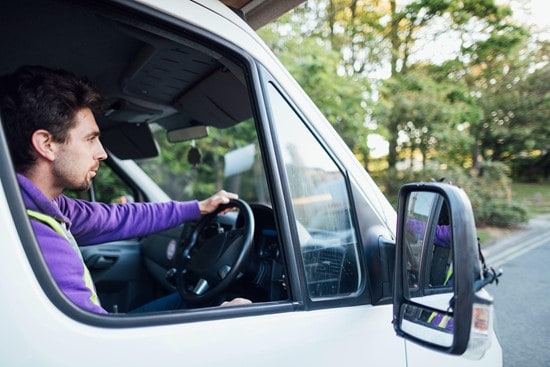
Driving a van for work: rules and regulations
Posted on 29th April 2022 by Katherine Ducie
Lots of people in the UK rely on a van for work, particularly tradespeople who need to carry their equipment and tools to their working destination.
Vans are also often thought to be more convenient, able to do more mileage and a more comfortable form of transport for multiple people, but what are the rules around licensing and driving a van?
Below, we’ve summed up who can and can’t drive a van on a standard licence, as well as weight limits, speed limits and van MOTs.
Can I drive a van for work?
First, you’re probably wondering whether you can drive a van on a standard driving licence, or whether you need an additional licence.
You can drive a van, both for work and personal use, that weighs up to 3,500kg with your standard car licence if you passed your test after 1st January 1997. If you passed your driving test before 1997, then you are allowed to drive vehicles that are up to 7,500kg, but only for personal use.
If you are required to drive a vehicle of this size as part of your job, you would need to undertake additional tests. Usually, this would be in the form of a Driver Certificate of Professional Competence (CPC), which involves 35 hours of training that must be repeated every five years. This is also the case if you tow a trailer on your van, even if the van weighs less than 3,500kg.
It’s really important to make sure that you have the correct licence to drive a van for work, or you could be faced with a fine of up to £1,000 and three to six penalty points.
Should you drive a plug-in hybrid or fully electric van, it’s worth considering that you can drive these with a standard licence up to 4,250kg. The Department of Transport introduced this rule as part of the Road to Zero strategy in 2019 because of the weight of electric batteries. The only caveat is that you must attend training from a Government-approved light-goods vehicle training provider, which takes around five hours.
When driving a van for work, it’s important to take into account the reduced speed limits too. Vans tend to have lower speed limits than cars because of their size and weight. Generally, vans and vans with trailers should drive at a maximum speed of 50mph on a single carriageway and 60mph on a dual carriageway. Vans can drive up to 70mph on motorways, but vans with trailers should stay under 60mph.
Vans and MOTs
MOTs are essential if you want to legally drive your van on the road. These tests are required every year, so don’t let your MOT run out.
Vans have slightly different MOT classes to cars, so do watch out for that when you take your van to a garage. A van is considered a Class 4 if it weighs up to 3,000kg (including its maximum recommended load) and Class 7 if it weighs 3,000kg to 3,500kg. If your van weighs more than 3,500kg, you will need a HGV, bus or trailer MOT.
When is an MOT due on a new van?
A new van will need its first MOT three years after it was first registered.
Are any vans MOT exempt?
It’s rare that a standard van will be exempt from an MOT, but there are some instances where large vehicles are exempt. These include but are not limited to:
- Vehicles designed for firefighting purposes
- Vehicles used solely for one or both of the following purposes:
- Clearing frost, ice or snow from roads by means of a snow plough or smaller contrivance, whether forming part of the vehicle or not, and
- Spreading material on roads to deal with frost, ice or snow.
- Motor vehicles constructed, and not merely adapted, for the purpose of street cleansing, or the collection or disposal of refuse or the collection or disposal of the contents of gullies.
- Category T tractors (though there are some exceptions)
- Public service vehicles
- Licensed taxis
- Vehicles used solely for the purpose of funerals.
- Track-laying vehicles.
- Living vans the design gross weight of which does not exceed 3,500kg.
Van weight limits
We’ve mentioned van weight limits a few times in this guide already, mainly referring to the ‘design gross weight’, which is the weight of the van when it’s fully loaded, has a full petrol tank and has the maximum number of people in. This is also sometimes known as ‘gross vehicle weight’, ‘maximum authorised mass’ (MAM) or ‘laden weight’.
It’s imperative that this number isn’t exceeded. This can be unsafe, as the tyres may not be able to cope with the weight, but you can also receive a fine, points on your licence or a court summons if you overload your work van.
If you’re unsure what the design gross weight of your van is, you can usually find this in the owner’s manual or on a sticker located on the inside of the driver’s side door. You may also be given the ‘gross train weight’, which is the total weight of the van plus a trailer, plus the trailer load. This is particularly important if you use a trailer with your work van.
CLICK HERE FOR A QUICK ONLINE TRADESMAN INSURANCE QUOTE
Related Articles:
Useful Links

